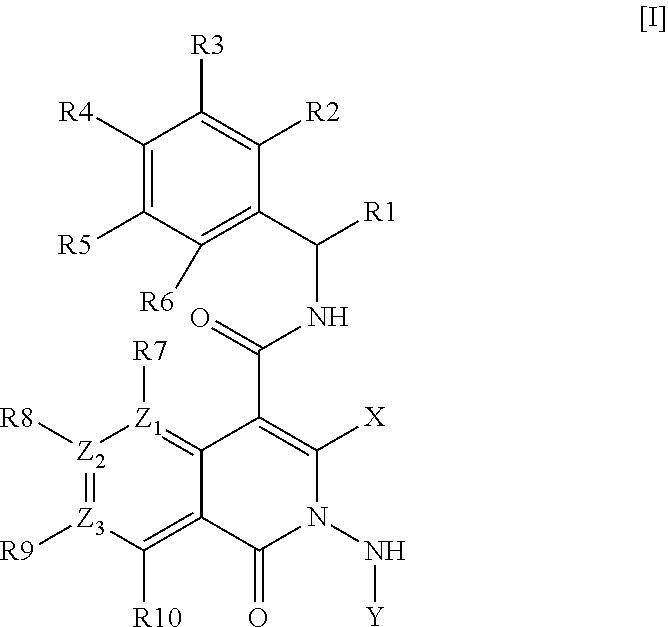Azaisoquinolinone derivatives as NK3 antagonists
- Summary
- Abstract
- Description
- Claims
- Application Information
AI Technical Summary
Benefits of technology
Problems solved by technology
Method used
Image
Examples
example 1
[0165]
1b 3-Methyl-1-oxo-2-propylamino-1,2-dihydro-[2,6]naphthyridine-4-carboxylic acid [(S)-cyclopropyl-(4-fluoro-phenyl)-methyl]-amide
[0166]2-(tert-Butoxycarbonyl-propyl-amino)-3-methyl-1-oxo-1,2-dihydro-2,6-naphthyridine-4-carboxylic acid (10 mg, 0.03 mmol) and C-[(S)-C-cyclopropyl-C-(4-fluoro-phenyl)]-methylamine (6.8 mg, 0.042 mmol) were dissolved in N,N-dimethylformamide (0.3 mL, 4 mmol). 1 -Hydroxybenzotriazole (5.6 mg, 0.042 mmol) was added. N-(3-Dimethylaminopropyl)-N′-ethylcarbodiimide hydrochloride (8.0 mg, 0.042 mmol) was added. Triethylamine (12 uL, 0.083 mmol) was added. The reaction mixture was stirred overnight at room temperature. Dichloromethane (150μL) and trifluoro acetic acid (150 μL) were added. The reaction mixture was stirred at room temperature for 2 hours. 150 μL Trifluoro acetic acid was added. The reaction mixture was stirred at 50° C. for 1 hour. The reaction mixture was concentrated in vacuo and the product was purified by preparative HPLC.
[0167]LC-MS...
example 2
[0175]
2a 6-Ethylamino-7-methyl-5-oxo-5,6-dihydro-[1,6]naphthyridine-8-carboxylic acid [(S)-cyclobutyl-(3-fluoro-phenyl)-methyl]-amide
[0176]LC-MS (m / z) 409.5 (MH+); tR=1.73
example 3
[0177]
3a 2-Ethylamino-3-methyl-1-oxo-1,2-dihydro-2,7-naphthyridine-4-carboxylic acid [(S)-cyclobutyl-(3-fluoro-phenyl)-methyl]-amide
[0178]4-Bromo-3-methyl-1-oxo-1H-2,7-naphthyridin-2-yl)-ethyl-carbamic acid tert-butyl ester (65 mg, 0.17 mmol) and C-[(S)-C-Cyclobutyl-C-(3-fluoro-phenyl)]-methylamine (45.7 mg, 0.255 mmol) were added to palladium(II) acetate (3.82 mg, 0.0170 mmol), 4,5-bis-diphenylphosphanyl-9,9-dimethyl-9H-xanthene (9.84 mg, 0.0170 mmol), and sodium carbonate (54.1 mg, 0.510 mmol) in Toluene (1 mL, 10 mmol). The reaction mixture was stirred under an atmosphere of Carbon Monoxide (2 bar) at 120° C. overnight. The reaction mixture was cooled to room temperature. Ethanol was added (20 mL). The mixture was filtered. The residue was suspended in water (200 mL) and ethyl acetate (200 mL). The mixture was acidified carefully with cone HCl (aq). The mixture was filtered. The organic phase of the filtrate was washed with brine, dried over MgSO4 and concentrated in vacuo and pu...
PUM
 Login to View More
Login to View More Abstract
Description
Claims
Application Information
 Login to View More
Login to View More - R&D
- Intellectual Property
- Life Sciences
- Materials
- Tech Scout
- Unparalleled Data Quality
- Higher Quality Content
- 60% Fewer Hallucinations
Browse by: Latest US Patents, China's latest patents, Technical Efficacy Thesaurus, Application Domain, Technology Topic, Popular Technical Reports.
© 2025 PatSnap. All rights reserved.Legal|Privacy policy|Modern Slavery Act Transparency Statement|Sitemap|About US| Contact US: help@patsnap.com



